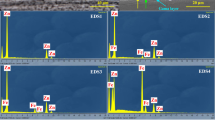Abstract
The passivity and passivity breakdown of 304 stainless steel were investigated in 0.25 M Na2SO4solutions of pH 10. The effect of applied potential and the presence of Cl− ions in the electrolyte were also studied. Different electrochemical methods such as open circuit potential measurements, polarization techniques and electrochemical impedance spectroscopy (EIS) were used. The results showed that the steel electrode passivates under open circuit conditions and also under potentiostatic control. The rate of passive film thickening under open circuit conditions follows a simple logarithmic law. Addition of Cl− ion shifts the polarization curves in the active direction and above a critical chloride concentration, [Cl− ] ≥ 0.15 M, pitting corrosion occurs and the pitting potential, E pit, decreases linearly with the logarithm of [Cl−]. The addition of sulphate ions to the chloride-containing solutions was found to inhibit the pitting process, and at [SO2- 4] ≥ 0.25 M, a complete immunity to pitting corrosion was recorded. The impedance measurements provided support for film thickening and film breakdown reactions. An equivalent circuit model which consists of a pure resistor, R Ω, in series with a parallel combination of a pure resistor, R p, and a constant phase element, Q, was proposed to describe the electrode/electrolyte interface. The passive film thickness was found to increase with applied potential up to a critical value of 0.3 V. At higher voltages, breakdown of the passive film occured.
Similar content being viewed by others
References
C.R. Clayton and I. Olefjord; in Corrosion Mechanisms in Theory and Practice, P. Marcis and J. Oudar, Editors, p 175, Marcel Decker, New York (1995), and references therein.
E. De Vito and P. Marcus, Surf. Interf. Anal, 19 (1992) 403.
W. Wang, D. Costa and P. Marcus, J. Electrochem. Soc., 141 (1994) 111.
V. Maricue, W. Yang and P. Marcus, J. Electrochem. Soc., 143 (1996) 1182.
S.S. El-Egamy, W.A. Badawy and H. Shehata, Corrosion Prevention Control, 47 (2000) 35.
S.S. El-Egamy, W.A. Badawy and H. Shehata, Mat. Wiss. und. Werkstofftech, 31 (2001)737.
S.I. Ali and G.J. Abbaschian, Corros. Sci., 18 (1978)15.
H.C. Man, D.R. Gabe, Corros. Sci., 21 (1981) 713.
J.J. Park, S.I. Pyun, W.J. Lee and H.P. Kim, Corrosion, 55 (1999) 380.
A.R. Brooks, C.R. Clayton, K. Doss and Y.C. Lu, J. Electrochem. Soc., 133 (1986) 2459.
T. Hong, G.W. Walter and M. Nagumo, Corros. Sci., 38 (1996) 1525.
J.H. Wang, C.C. Su and Z. Zsklarska-Smialowska, Corrosion, 44 (1988) 732.
S.T. Amaral and I.L. Muller, Corros. Sci., 41 (1999) 747.
T. Kodoma, 5th Int. Congr. Metallic Corrosion, p. 223, NACE, Houston 1974.
R.P. Frankenthal and H.W. Pickering, J. Electrochem. Soc., 119 (1972) 1304.
Z. Szklarska-Smialowska, Corros. Sci., 18 (1978) 97.
A. Kolics, J.C. Polkinghorne and A. Wieckowski, Electrochim. Acta, 43 (1998) 2605.
M. Keddam, O. R. Mattos and H. Taken; Electrochim. Acta, 31 (1986) 1159.
A. L. Dobbelaar, E. C. M. Herman and J. H. W. De Wit; Corros. Sci., 33 (1992) 765.
D. D. Macdonald and Urquidi-Macdonald in Modification of Passive Films; P. Marcus, B. Baroux and M. Keddam, Editors, p. 46, Ins. Of Materials, London (1994).
D. D. Macdonald, S. R. Biaggio and H. Song; J. Electrochem. Soc., 139 (1992) 17.
J.R. Macdonald, “Impedance Spectroscopy” New York, N.Y., John Wiley & Sons, 1987.
K. Juttner, W.J. Lorenz and W. Paatsch, Corros. Sci., 29 (1989) 279.
U. Rammelt and R. Reinhard, Corros. Sci., 27 (1987) 373.
K Juettner, W.J. Lorenz, W. Paatsch, M.W. Kendig and F. Mansfeld, Werkst. und Korros., 36 (1985) 120.
S.C. Thomas and V.I. Birss, J. Electrochem. Soc., 144 (1997) 1353.
J.W. Diggle, T.C. Downie and C.W. Goulding, Electrochim. Acta, 15 (1970) 1079.
S.M. Abd El-Motaal, N.H. Hilal and W.A. Badawy, Electrochim. Acta, 39 (1994) 3611.
Author information
Authors and Affiliations
Rights and permissions
About this article
Cite this article
El-egamy, S.S., Badaway, W.A. Passivity and passivity breakdown of 304 stainless steel in alkaline sodium sulphate solutions. Journal of Applied Electrochemistry 34, 1153–1158 (2004). https://doi.org/10.1007/s10800-004-1709-x
Issue Date:
DOI: https://doi.org/10.1007/s10800-004-1709-x




